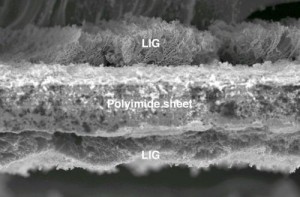
The flexible material created at Rice University has the potential for use in electronics or for energy storage.
Image: Tour Group/Rice University
James Tour and his group at Rice University have developed and tested a flexible, three-dimensional supercapacitor with the potential to be scaled up for commercial applications.
In this study, the researchers advanced what they had already developed in laser-induced graphene (LIG) by producing and testing the stacked, three-dimensional supercapacitors.
Their prior findings showed that firing a laser at an inexpensive polymer burned off other elements and left a film of porous graphene, which has the potential to be the perfect electrode for supercapacitors or electronic circuits.
The researchers began by making vertically aligned supercapacitors with laser-induced graphene on both sides of a polymer sheet.
This from Rice University:
The flexible stacks show excellent energy-storage capacity and power potential and can be scaled up for commercial applications. LIG can be made in air at ambient temperature, perhaps in industrial quantities through roll-to-roll processes, Tour said.
The LIG supercapacitors are able to do all of the things a typical capacitor can do with the added bonus of flexibility, so they can be rolled within a cylinder.
“What we’ve made are comparable to microsupercapacitors being commercialized now, but our ability to put devices into a 3-D configuration allows us to pack a lot of them into a very small area,” Tour said. “We simply stack them up.”
To find out more about innovative technology in supercapacitors, make sure to attend the 227th ECS Meeting, where we will host a Batteries and Energy Storage symposium devoted to new materials and designs, performance studies, and modeling of all types of batteries, supercapacitors, and fuel cells including aqueous, non-aqueous, polymer electrolytes, solid electrolytes, and flow systems.
In the mean time, head over to the Digital Library to check out the latest research in supercapacitors.


